MBAEX 15/14: Marketing Strategies of Hatchback Cars in India Project
VerifiedAdded on 2021/03/22
|12
|4885
|90
Project
AI Summary
This project report provides a detailed analysis of the marketing strategies employed by hatchback car brands in India, with a specific focus on the period before and after the introduction of the Nissan Micra. The report begins with an introduction to the Indian automobile industry and its significance, followed by an examination of consumer behavior, segmentation, targeting, and positioning strategies. It highlights how consumer preferences and buying behaviors have evolved, particularly in response to the entry of foreign brands like Nissan Micra, and analyzes the key segmentation variables, including reason for purchase, decision roles, and brand loyalty. Furthermore, the report explores the marketing mix elements, including product features, the product life cycle, and the BCG matrix, providing insights into how these elements have adapted to changing market dynamics. The report also examines the impact of brand endorsements and the 3 Ps of services in the hatchback car sales and services. The project concludes by evaluating the positioning strategies adopted by various car brands, such as Maruti Suzuki and Hyundai, and providing a comprehensive overview of the changing landscape of the Indian hatchback car market.
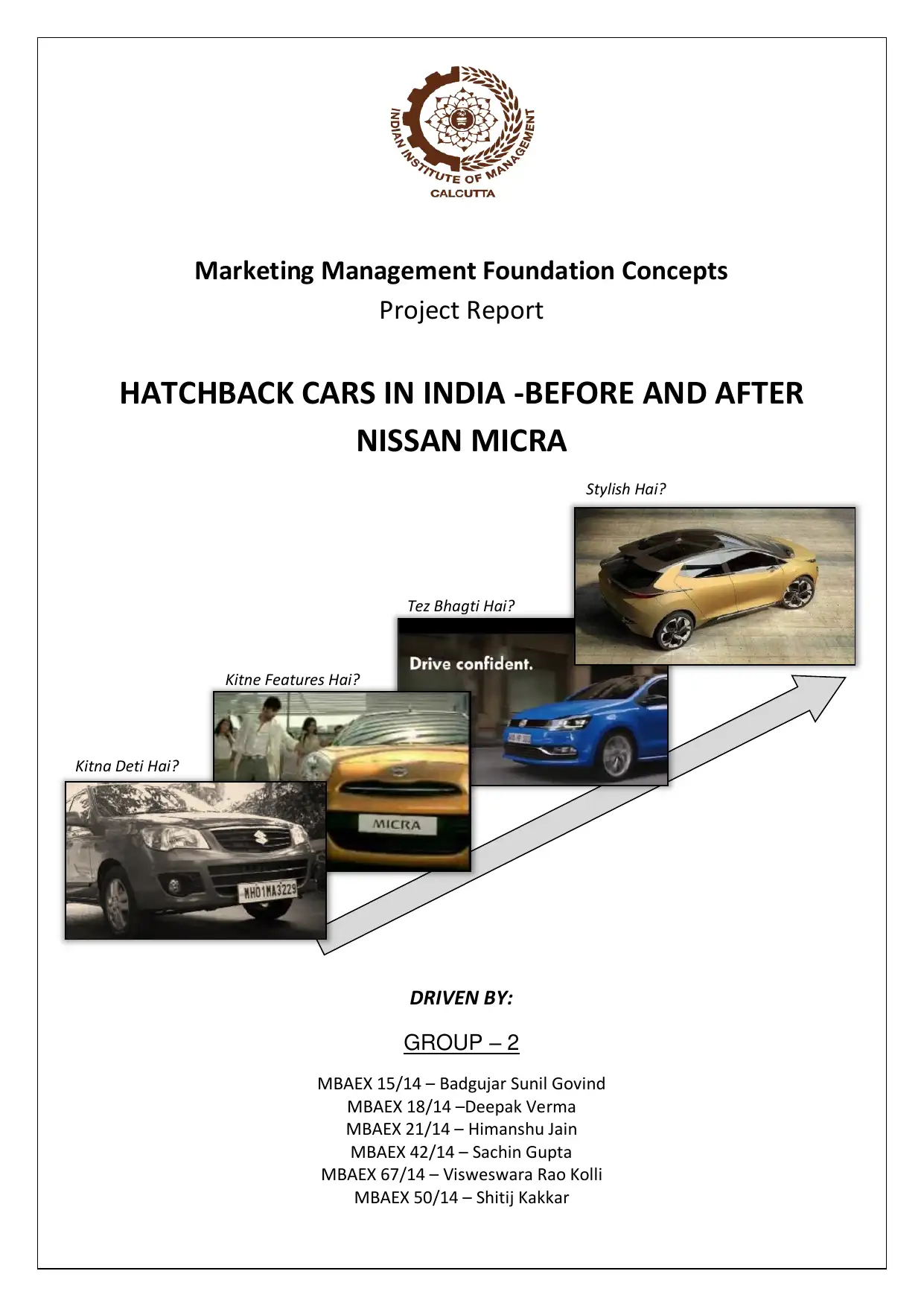
Marketing Management Foundation Concepts
Project Report
HATCHBACK CARS IN INDIA -BEFORE AND AFTER
NISSAN MICRA
DRIVEN BY:
GROUP – 2
MBAEX 15/14 – Badgujar Sunil Govind
MBAEX 18/14 –Deepak Verma
MBAEX 21/14 – Himanshu Jain
MBAEX 42/14 – Sachin Gupta
MBAEX 67/14 – Visweswara Rao Kolli
MBAEX 50/14 – Shitij Kakkar
Kitna Deti Hai?
Tez Bhagti Hai?
Kitne Features Hai?
Stylish Hai?
Project Report
HATCHBACK CARS IN INDIA -BEFORE AND AFTER
NISSAN MICRA
DRIVEN BY:
GROUP – 2
MBAEX 15/14 – Badgujar Sunil Govind
MBAEX 18/14 –Deepak Verma
MBAEX 21/14 – Himanshu Jain
MBAEX 42/14 – Sachin Gupta
MBAEX 67/14 – Visweswara Rao Kolli
MBAEX 50/14 – Shitij Kakkar
Kitna Deti Hai?
Tez Bhagti Hai?
Kitne Features Hai?
Stylish Hai?
Paraphrase This Document
Need a fresh take? Get an instant paraphrase of this document with our AI Paraphraser

Contents
Introduction ................................................................................................................................................................ 2
Consumer Behaviour................................................................................................................................................... 2
Segmentation ............................................................................................................................................................. 3
Targeting .................................................................................................................................................................... 3
Positioning .................................................................................................................................................................. 4
Brand Endorsement .................................................................................................................................................... 5
Marketing Mix ............................................................................................................................................................ 5
Introduction ................................................................................................................................................................ 2
Consumer Behaviour................................................................................................................................................... 2
Segmentation ............................................................................................................................................................. 3
Targeting .................................................................................................................................................................... 3
Positioning .................................................................................................................................................................. 4
Brand Endorsement .................................................................................................................................................... 5
Marketing Mix ............................................................................................................................................................ 5
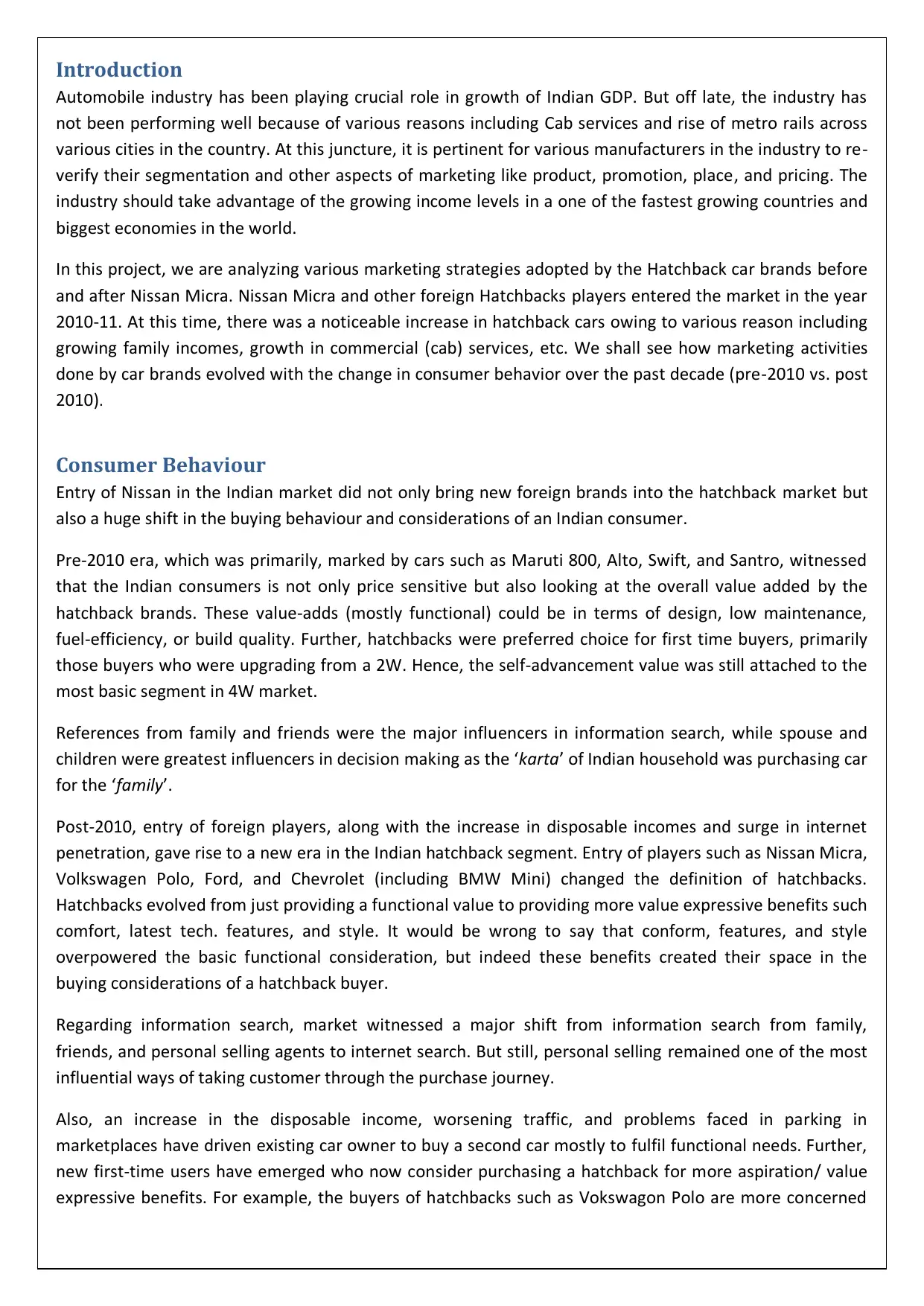
Introduction
Automobile industry has been playing crucial role in growth of Indian GDP. But off late, the industry has
not been performing well because of various reasons including Cab services and rise of metro rails across
various cities in the country. At this juncture, it is pertinent for various manufacturers in the industry to re-
verify their segmentation and other aspects of marketing like product, promotion, place, and pricing. The
industry should take advantage of the growing income levels in a one of the fastest growing countries and
biggest economies in the world.
In this project, we are analyzing various marketing strategies adopted by the Hatchback car brands before
and after Nissan Micra. Nissan Micra and other foreign Hatchbacks players entered the market in the year
2010-11. At this time, there was a noticeable increase in hatchback cars owing to various reason including
growing family incomes, growth in commercial (cab) services, etc. We shall see how marketing activities
done by car brands evolved with the change in consumer behavior over the past decade (pre-2010 vs. post
2010).
Consumer Behaviour
Entry of Nissan in the Indian market did not only bring new foreign brands into the hatchback market but
also a huge shift in the buying behaviour and considerations of an Indian consumer.
Pre-2010 era, which was primarily, marked by cars such as Maruti 800, Alto, Swift, and Santro, witnessed
that the Indian consumers is not only price sensitive but also looking at the overall value added by the
hatchback brands. These value-adds (mostly functional) could be in terms of design, low maintenance,
fuel-efficiency, or build quality. Further, hatchbacks were preferred choice for first time buyers, primarily
those buyers who were upgrading from a 2W. Hence, the self-advancement value was still attached to the
most basic segment in 4W market.
References from family and friends were the major influencers in information search, while spouse and
children were greatest influencers in decision making as the ‘karta’ of Indian household was purchasing car
for the ‘family’.
Post-2010, entry of foreign players, along with the increase in disposable incomes and surge in internet
penetration, gave rise to a new era in the Indian hatchback segment. Entry of players such as Nissan Micra,
Volkswagen Polo, Ford, and Chevrolet (including BMW Mini) changed the definition of hatchbacks.
Hatchbacks evolved from just providing a functional value to providing more value expressive benefits such
comfort, latest tech. features, and style. It would be wrong to say that conform, features, and style
overpowered the basic functional consideration, but indeed these benefits created their space in the
buying considerations of a hatchback buyer.
Regarding information search, market witnessed a major shift from information search from family,
friends, and personal selling agents to internet search. But still, personal selling remained one of the most
influential ways of taking customer through the purchase journey.
Also, an increase in the disposable income, worsening traffic, and problems faced in parking in
marketplaces have driven existing car owner to buy a second car mostly to fulfil functional needs. Further,
new first-time users have emerged who now consider purchasing a hatchback for more aspiration/ value
expressive benefits. For example, the buyers of hatchbacks such as Vokswagon Polo are more concerned
Automobile industry has been playing crucial role in growth of Indian GDP. But off late, the industry has
not been performing well because of various reasons including Cab services and rise of metro rails across
various cities in the country. At this juncture, it is pertinent for various manufacturers in the industry to re-
verify their segmentation and other aspects of marketing like product, promotion, place, and pricing. The
industry should take advantage of the growing income levels in a one of the fastest growing countries and
biggest economies in the world.
In this project, we are analyzing various marketing strategies adopted by the Hatchback car brands before
and after Nissan Micra. Nissan Micra and other foreign Hatchbacks players entered the market in the year
2010-11. At this time, there was a noticeable increase in hatchback cars owing to various reason including
growing family incomes, growth in commercial (cab) services, etc. We shall see how marketing activities
done by car brands evolved with the change in consumer behavior over the past decade (pre-2010 vs. post
2010).
Consumer Behaviour
Entry of Nissan in the Indian market did not only bring new foreign brands into the hatchback market but
also a huge shift in the buying behaviour and considerations of an Indian consumer.
Pre-2010 era, which was primarily, marked by cars such as Maruti 800, Alto, Swift, and Santro, witnessed
that the Indian consumers is not only price sensitive but also looking at the overall value added by the
hatchback brands. These value-adds (mostly functional) could be in terms of design, low maintenance,
fuel-efficiency, or build quality. Further, hatchbacks were preferred choice for first time buyers, primarily
those buyers who were upgrading from a 2W. Hence, the self-advancement value was still attached to the
most basic segment in 4W market.
References from family and friends were the major influencers in information search, while spouse and
children were greatest influencers in decision making as the ‘karta’ of Indian household was purchasing car
for the ‘family’.
Post-2010, entry of foreign players, along with the increase in disposable incomes and surge in internet
penetration, gave rise to a new era in the Indian hatchback segment. Entry of players such as Nissan Micra,
Volkswagen Polo, Ford, and Chevrolet (including BMW Mini) changed the definition of hatchbacks.
Hatchbacks evolved from just providing a functional value to providing more value expressive benefits such
comfort, latest tech. features, and style. It would be wrong to say that conform, features, and style
overpowered the basic functional consideration, but indeed these benefits created their space in the
buying considerations of a hatchback buyer.
Regarding information search, market witnessed a major shift from information search from family,
friends, and personal selling agents to internet search. But still, personal selling remained one of the most
influential ways of taking customer through the purchase journey.
Also, an increase in the disposable income, worsening traffic, and problems faced in parking in
marketplaces have driven existing car owner to buy a second car mostly to fulfil functional needs. Further,
new first-time users have emerged who now consider purchasing a hatchback for more aspiration/ value
expressive benefits. For example, the buyers of hatchbacks such as Vokswagon Polo are more concerned
⊘ This is a preview!⊘
Do you want full access?
Subscribe today to unlock all pages.

Trusted by 1+ million students worldwide
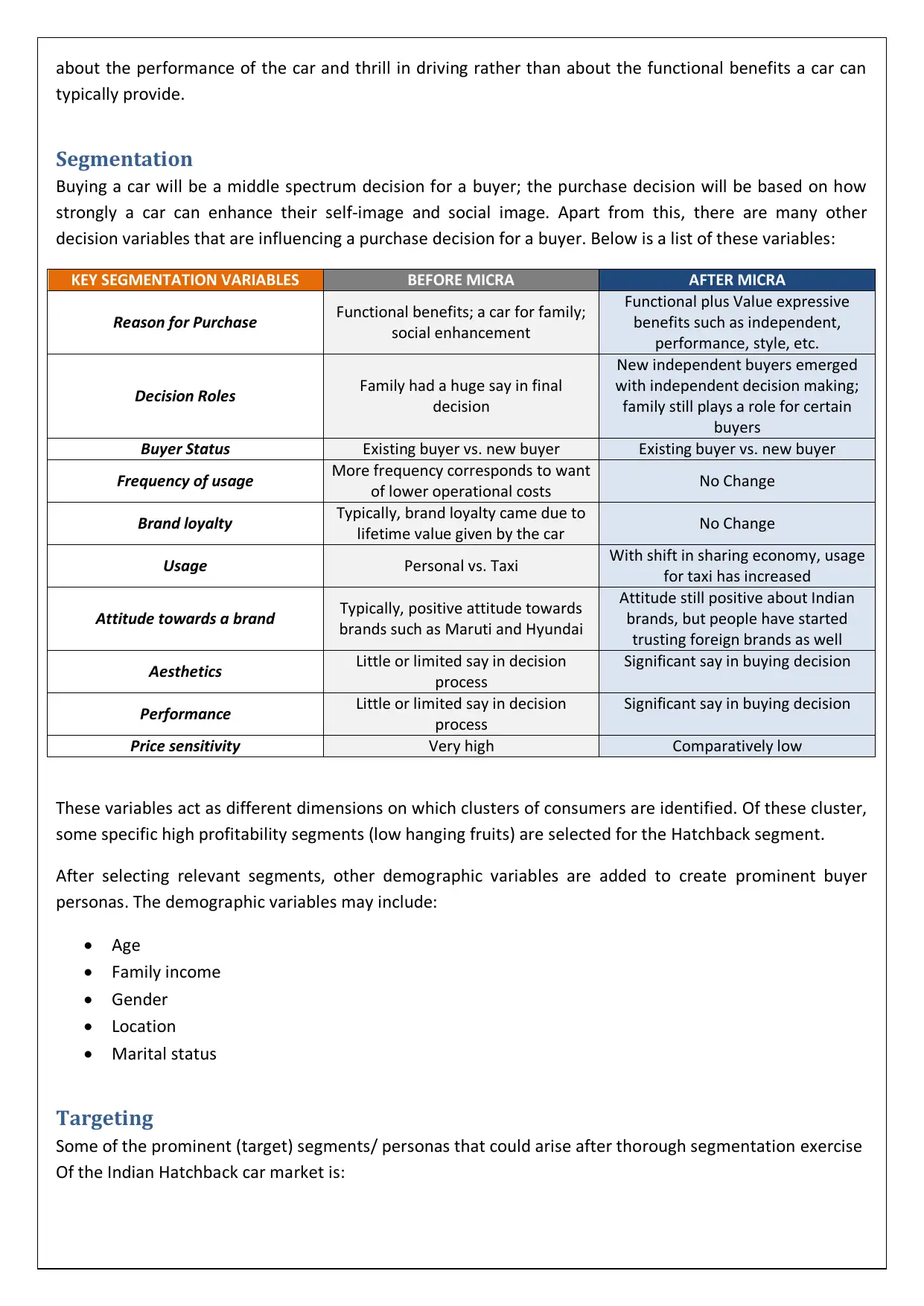
about the performance of the car and thrill in driving rather than about the functional benefits a car can
typically provide.
Segmentation
Buying a car will be a middle spectrum decision for a buyer; the purchase decision will be based on how
strongly a car can enhance their self-image and social image. Apart from this, there are many other
decision variables that are influencing a purchase decision for a buyer. Below is a list of these variables:
KEY SEGMENTATION VARIABLES BEFORE MICRA AFTER MICRA
Reason for Purchase Functional benefits; a car for family;
social enhancement
Functional plus Value expressive
benefits such as independent,
performance, style, etc.
Decision Roles Family had a huge say in final
decision
New independent buyers emerged
with independent decision making;
family still plays a role for certain
buyers
Buyer Status Existing buyer vs. new buyer Existing buyer vs. new buyer
Frequency of usage More frequency corresponds to want
of lower operational costs No Change
Brand loyalty Typically, brand loyalty came due to
lifetime value given by the car No Change
Usage Personal vs. Taxi With shift in sharing economy, usage
for taxi has increased
Attitude towards a brand Typically, positive attitude towards
brands such as Maruti and Hyundai
Attitude still positive about Indian
brands, but people have started
trusting foreign brands as well
Aesthetics Little or limited say in decision
process
Significant say in buying decision
Performance Little or limited say in decision
process
Significant say in buying decision
Price sensitivity Very high Comparatively low
These variables act as different dimensions on which clusters of consumers are identified. Of these cluster,
some specific high profitability segments (low hanging fruits) are selected for the Hatchback segment.
After selecting relevant segments, other demographic variables are added to create prominent buyer
personas. The demographic variables may include:
• Age
• Family income
• Gender
• Location
• Marital status
Targeting
Some of the prominent (target) segments/ personas that could arise after thorough segmentation exercise
Of the Indian Hatchback car market is:
typically provide.
Segmentation
Buying a car will be a middle spectrum decision for a buyer; the purchase decision will be based on how
strongly a car can enhance their self-image and social image. Apart from this, there are many other
decision variables that are influencing a purchase decision for a buyer. Below is a list of these variables:
KEY SEGMENTATION VARIABLES BEFORE MICRA AFTER MICRA
Reason for Purchase Functional benefits; a car for family;
social enhancement
Functional plus Value expressive
benefits such as independent,
performance, style, etc.
Decision Roles Family had a huge say in final
decision
New independent buyers emerged
with independent decision making;
family still plays a role for certain
buyers
Buyer Status Existing buyer vs. new buyer Existing buyer vs. new buyer
Frequency of usage More frequency corresponds to want
of lower operational costs No Change
Brand loyalty Typically, brand loyalty came due to
lifetime value given by the car No Change
Usage Personal vs. Taxi With shift in sharing economy, usage
for taxi has increased
Attitude towards a brand Typically, positive attitude towards
brands such as Maruti and Hyundai
Attitude still positive about Indian
brands, but people have started
trusting foreign brands as well
Aesthetics Little or limited say in decision
process
Significant say in buying decision
Performance Little or limited say in decision
process
Significant say in buying decision
Price sensitivity Very high Comparatively low
These variables act as different dimensions on which clusters of consumers are identified. Of these cluster,
some specific high profitability segments (low hanging fruits) are selected for the Hatchback segment.
After selecting relevant segments, other demographic variables are added to create prominent buyer
personas. The demographic variables may include:
• Age
• Family income
• Gender
• Location
• Marital status
Targeting
Some of the prominent (target) segments/ personas that could arise after thorough segmentation exercise
Of the Indian Hatchback car market is:
Paraphrase This Document
Need a fresh take? Get an instant paraphrase of this document with our AI Paraphraser
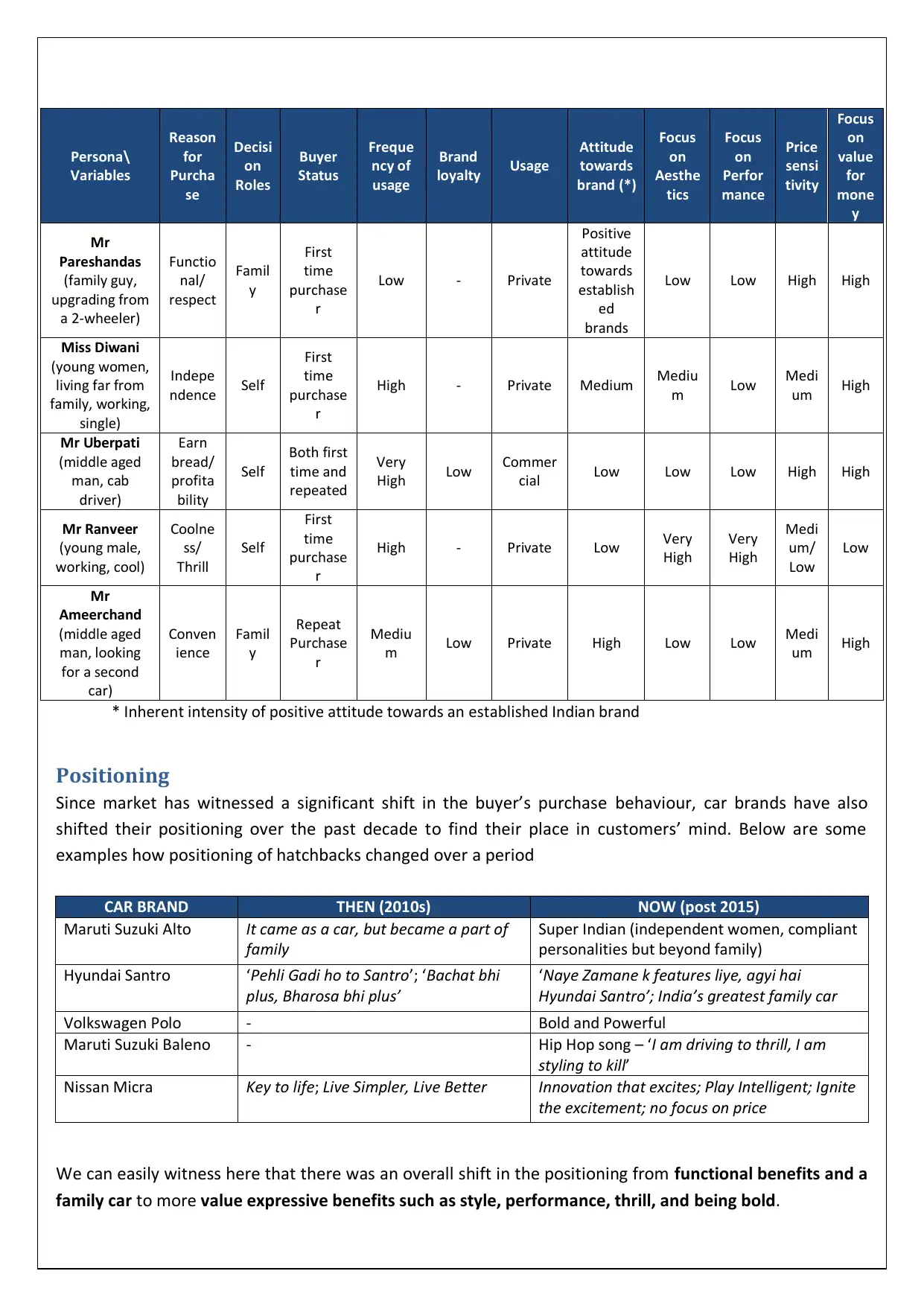
Persona\
Variables
Reason
for
Purcha
se
Decisi
on
Roles
Buyer
Status
Freque
ncy of
usage
Brand
loyalty Usage
Attitude
towards
brand (*)
Focus
on
Aesthe
tics
Focus
on
Perfor
mance
Price
sensi
tivity
Focus
on
value
for
mone
y
Mr
Pareshandas
(family guy,
upgrading from
a 2-wheeler)
Functio
nal/
respect
Famil
y
First
time
purchase
r
Low - Private
Positive
attitude
towards
establish
ed
brands
Low Low High High
Miss Diwani
(young women,
living far from
family, working,
single)
Indepe
ndence Self
First
time
purchase
r
High - Private Medium Mediu
m Low Medi
um High
Mr Uberpati
(middle aged
man, cab
driver)
Earn
bread/
profita
bility
Self
Both first
time and
repeated
Very
High Low Commer
cial Low Low Low High High
Mr Ranveer
(young male,
working, cool)
Coolne
ss/
Thrill
Self
First
time
purchase
r
High - Private Low Very
High
Very
High
Medi
um/
Low
Low
Mr
Ameerchand
(middle aged
man, looking
for a second
car)
Conven
ience
Famil
y
Repeat
Purchase
r
Mediu
m Low Private High Low Low Medi
um High
* Inherent intensity of positive attitude towards an established Indian brand
Positioning
Since market has witnessed a significant shift in the buyer’s purchase behaviour, car brands have also
shifted their positioning over the past decade to find their place in customers’ mind. Below are some
examples how positioning of hatchbacks changed over a period
CAR BRAND THEN (2010s) NOW (post 2015)
Maruti Suzuki Alto It came as a car, but became a part of
family
Super Indian (independent women, compliant
personalities but beyond family)
Hyundai Santro ‘Pehli Gadi ho to Santro’; ‘Bachat bhi
plus, Bharosa bhi plus’
‘Naye Zamane k features liye, agyi hai
Hyundai Santro’; India’s greatest family car
Volkswagen Polo - Bold and Powerful
Maruti Suzuki Baleno - Hip Hop song – ‘I am driving to thrill, I am
styling to kill’
Nissan Micra Key to life; Live Simpler, Live Better Innovation that excites; Play Intelligent; Ignite
the excitement; no focus on price
We can easily witness here that there was an overall shift in the positioning from functional benefits and a
family car to more value expressive benefits such as style, performance, thrill, and being bold.
Variables
Reason
for
Purcha
se
Decisi
on
Roles
Buyer
Status
Freque
ncy of
usage
Brand
loyalty Usage
Attitude
towards
brand (*)
Focus
on
Aesthe
tics
Focus
on
Perfor
mance
Price
sensi
tivity
Focus
on
value
for
mone
y
Mr
Pareshandas
(family guy,
upgrading from
a 2-wheeler)
Functio
nal/
respect
Famil
y
First
time
purchase
r
Low - Private
Positive
attitude
towards
establish
ed
brands
Low Low High High
Miss Diwani
(young women,
living far from
family, working,
single)
Indepe
ndence Self
First
time
purchase
r
High - Private Medium Mediu
m Low Medi
um High
Mr Uberpati
(middle aged
man, cab
driver)
Earn
bread/
profita
bility
Self
Both first
time and
repeated
Very
High Low Commer
cial Low Low Low High High
Mr Ranveer
(young male,
working, cool)
Coolne
ss/
Thrill
Self
First
time
purchase
r
High - Private Low Very
High
Very
High
Medi
um/
Low
Low
Mr
Ameerchand
(middle aged
man, looking
for a second
car)
Conven
ience
Famil
y
Repeat
Purchase
r
Mediu
m Low Private High Low Low Medi
um High
* Inherent intensity of positive attitude towards an established Indian brand
Positioning
Since market has witnessed a significant shift in the buyer’s purchase behaviour, car brands have also
shifted their positioning over the past decade to find their place in customers’ mind. Below are some
examples how positioning of hatchbacks changed over a period
CAR BRAND THEN (2010s) NOW (post 2015)
Maruti Suzuki Alto It came as a car, but became a part of
family
Super Indian (independent women, compliant
personalities but beyond family)
Hyundai Santro ‘Pehli Gadi ho to Santro’; ‘Bachat bhi
plus, Bharosa bhi plus’
‘Naye Zamane k features liye, agyi hai
Hyundai Santro’; India’s greatest family car
Volkswagen Polo - Bold and Powerful
Maruti Suzuki Baleno - Hip Hop song – ‘I am driving to thrill, I am
styling to kill’
Nissan Micra Key to life; Live Simpler, Live Better Innovation that excites; Play Intelligent; Ignite
the excitement; no focus on price
We can easily witness here that there was an overall shift in the positioning from functional benefits and a
family car to more value expressive benefits such as style, performance, thrill, and being bold.
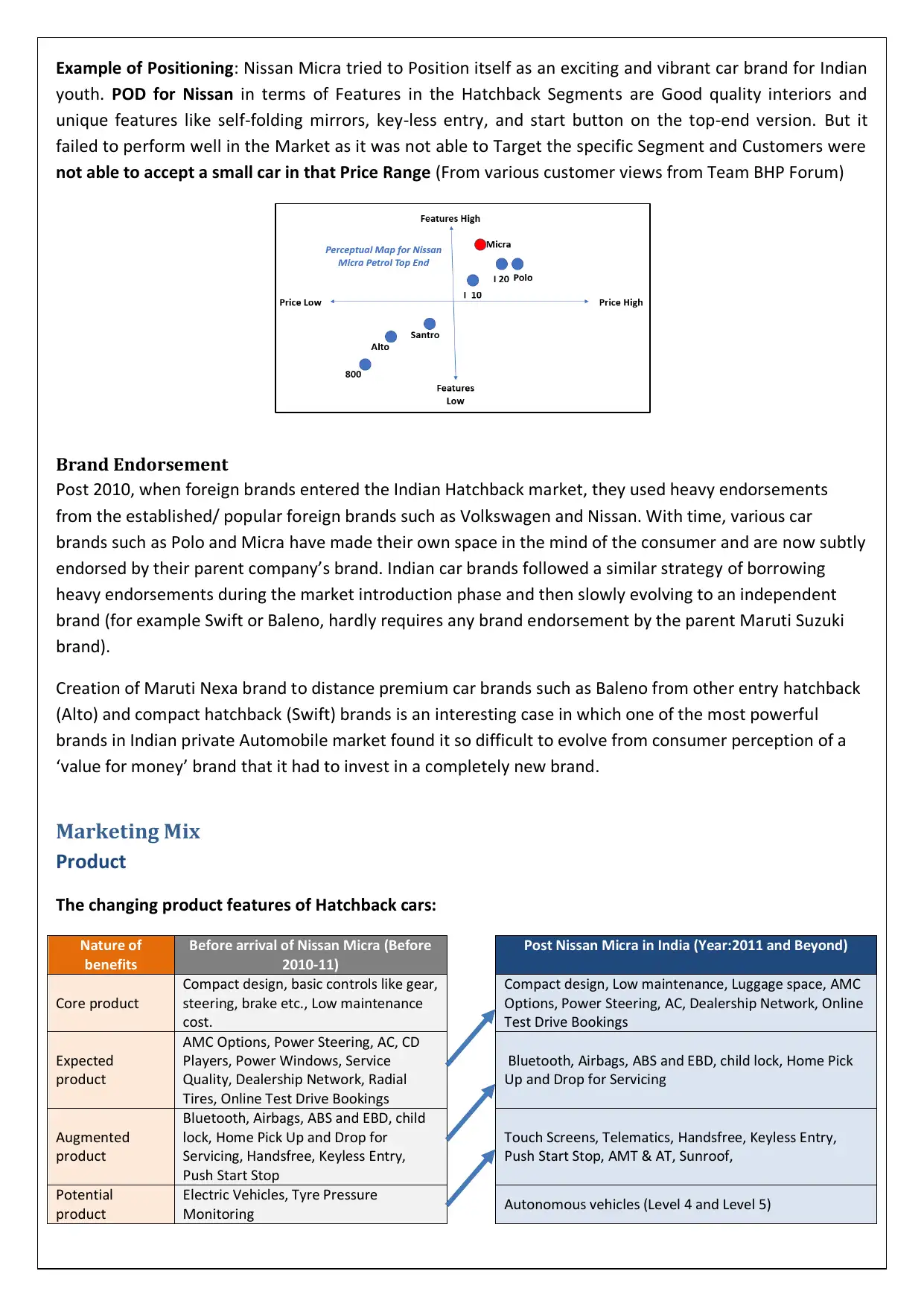
Example of Positioning: Nissan Micra tried to Position itself as an exciting and vibrant car brand for Indian
youth. POD for Nissan in terms of Features in the Hatchback Segments are Good quality interiors and
unique features like self-folding mirrors, key-less entry, and start button on the top-end version. But it
failed to perform well in the Market as it was not able to Target the specific Segment and Customers were
not able to accept a small car in that Price Range (From various customer views from Team BHP Forum)
Brand Endorsement
Post 2010, when foreign brands entered the Indian Hatchback market, they used heavy endorsements
from the established/ popular foreign brands such as Volkswagen and Nissan. With time, various car
brands such as Polo and Micra have made their own space in the mind of the consumer and are now subtly
endorsed by their parent company’s brand. Indian car brands followed a similar strategy of borrowing
heavy endorsements during the market introduction phase and then slowly evolving to an independent
brand (for example Swift or Baleno, hardly requires any brand endorsement by the parent Maruti Suzuki
brand).
Creation of Maruti Nexa brand to distance premium car brands such as Baleno from other entry hatchback
(Alto) and compact hatchback (Swift) brands is an interesting case in which one of the most powerful
brands in Indian private Automobile market found it so difficult to evolve from consumer perception of a
‘value for money’ brand that it had to invest in a completely new brand.
Marketing Mix
Product
The changing product features of Hatchback cars:
Nature of
benefits
Before arrival of Nissan Micra (Before
2010-11)
Post Nissan Micra in India (Year:2011 and Beyond)
Core product
Compact design, basic controls like gear,
steering, brake etc., Low maintenance
cost.
Compact design, Low maintenance, Luggage space, AMC
Options, Power Steering, AC, Dealership Network, Online
Test Drive Bookings
Expected
product
AMC Options, Power Steering, AC, CD
Players, Power Windows, Service
Quality, Dealership Network, Radial
Tires, Online Test Drive Bookings
Bluetooth, Airbags, ABS and EBD, child lock, Home Pick
Up and Drop for Servicing
Augmented
product
Bluetooth, Airbags, ABS and EBD, child
lock, Home Pick Up and Drop for
Servicing, Handsfree, Keyless Entry,
Push Start Stop
Touch Screens, Telematics, Handsfree, Keyless Entry,
Push Start Stop, AMT & AT, Sunroof,
Potential
product
Electric Vehicles, Tyre Pressure
Monitoring Autonomous vehicles (Level 4 and Level 5)
youth. POD for Nissan in terms of Features in the Hatchback Segments are Good quality interiors and
unique features like self-folding mirrors, key-less entry, and start button on the top-end version. But it
failed to perform well in the Market as it was not able to Target the specific Segment and Customers were
not able to accept a small car in that Price Range (From various customer views from Team BHP Forum)
Brand Endorsement
Post 2010, when foreign brands entered the Indian Hatchback market, they used heavy endorsements
from the established/ popular foreign brands such as Volkswagen and Nissan. With time, various car
brands such as Polo and Micra have made their own space in the mind of the consumer and are now subtly
endorsed by their parent company’s brand. Indian car brands followed a similar strategy of borrowing
heavy endorsements during the market introduction phase and then slowly evolving to an independent
brand (for example Swift or Baleno, hardly requires any brand endorsement by the parent Maruti Suzuki
brand).
Creation of Maruti Nexa brand to distance premium car brands such as Baleno from other entry hatchback
(Alto) and compact hatchback (Swift) brands is an interesting case in which one of the most powerful
brands in Indian private Automobile market found it so difficult to evolve from consumer perception of a
‘value for money’ brand that it had to invest in a completely new brand.
Marketing Mix
Product
The changing product features of Hatchback cars:
Nature of
benefits
Before arrival of Nissan Micra (Before
2010-11)
Post Nissan Micra in India (Year:2011 and Beyond)
Core product
Compact design, basic controls like gear,
steering, brake etc., Low maintenance
cost.
Compact design, Low maintenance, Luggage space, AMC
Options, Power Steering, AC, Dealership Network, Online
Test Drive Bookings
Expected
product
AMC Options, Power Steering, AC, CD
Players, Power Windows, Service
Quality, Dealership Network, Radial
Tires, Online Test Drive Bookings
Bluetooth, Airbags, ABS and EBD, child lock, Home Pick
Up and Drop for Servicing
Augmented
product
Bluetooth, Airbags, ABS and EBD, child
lock, Home Pick Up and Drop for
Servicing, Handsfree, Keyless Entry,
Push Start Stop
Touch Screens, Telematics, Handsfree, Keyless Entry,
Push Start Stop, AMT & AT, Sunroof,
Potential
product
Electric Vehicles, Tyre Pressure
Monitoring Autonomous vehicles (Level 4 and Level 5)
⊘ This is a preview!⊘
Do you want full access?
Subscribe today to unlock all pages.

Trusted by 1+ million students worldwide
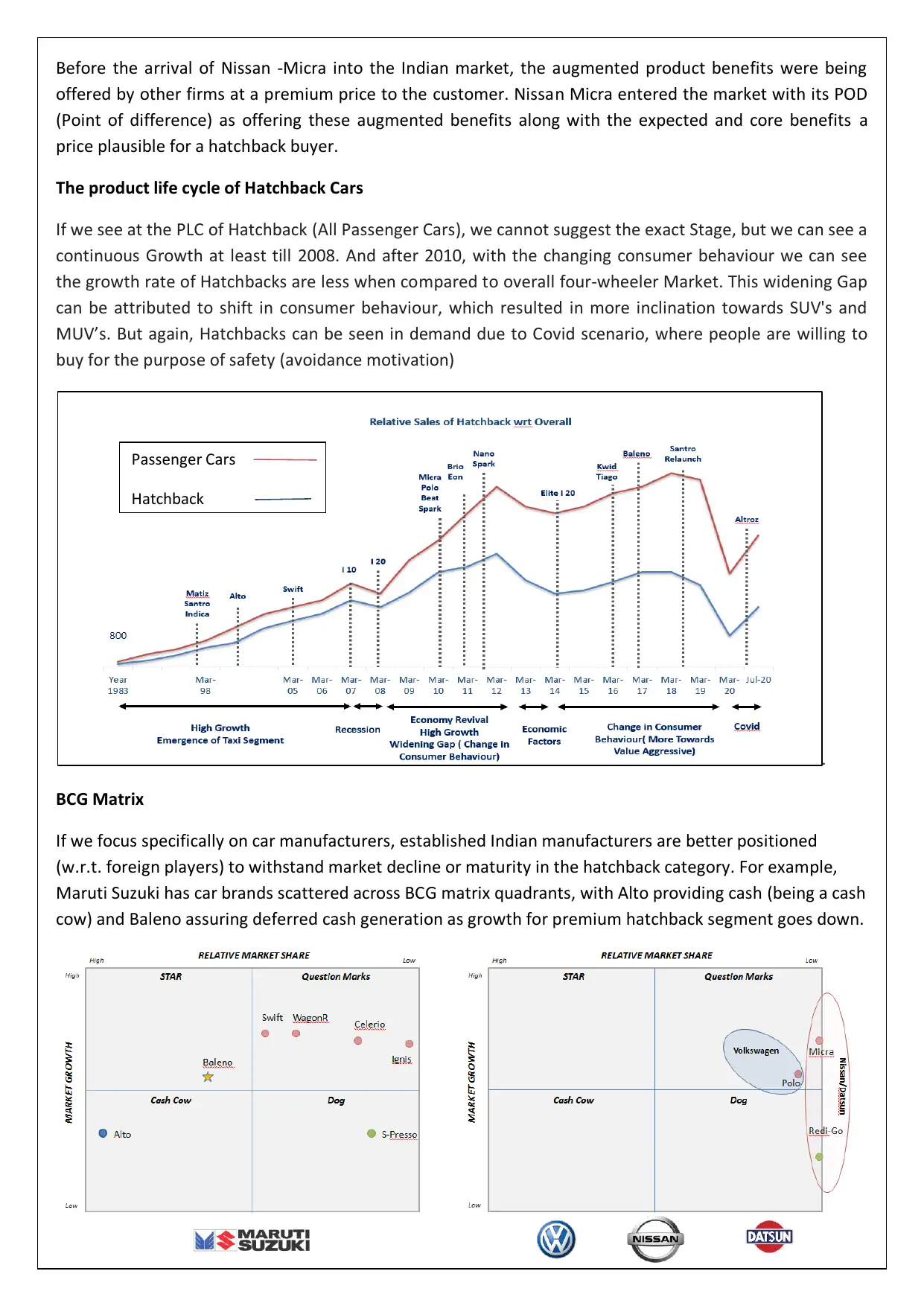
Before the arrival of Nissan -Micra into the Indian market, the augmented product benefits were being
offered by other firms at a premium price to the customer. Nissan Micra entered the market with its POD
(Point of difference) as offering these augmented benefits along with the expected and core benefits a
price plausible for a hatchback buyer.
The product life cycle of Hatchback Cars
If we see at the PLC of Hatchback (All Passenger Cars), we cannot suggest the exact Stage, but we can see a
continuous Growth at least till 2008. And after 2010, with the changing consumer behaviour we can see
the growth rate of Hatchbacks are less when compared to overall four-wheeler Market. This widening Gap
can be attributed to shift in consumer behaviour, which resulted in more inclination towards SUV's and
MUV’s. But again, Hatchbacks can be seen in demand due to Covid scenario, where people are willing to
buy for the purpose of safety (avoidance motivation)
.
BCG Matrix
If we focus specifically on car manufacturers, established Indian manufacturers are better positioned
(w.r.t. foreign players) to withstand market decline or maturity in the hatchback category. For example,
Maruti Suzuki has car brands scattered across BCG matrix quadrants, with Alto providing cash (being a cash
cow) and Baleno assuring deferred cash generation as growth for premium hatchback segment goes down.
Passenger Cars
Hatchback
offered by other firms at a premium price to the customer. Nissan Micra entered the market with its POD
(Point of difference) as offering these augmented benefits along with the expected and core benefits a
price plausible for a hatchback buyer.
The product life cycle of Hatchback Cars
If we see at the PLC of Hatchback (All Passenger Cars), we cannot suggest the exact Stage, but we can see a
continuous Growth at least till 2008. And after 2010, with the changing consumer behaviour we can see
the growth rate of Hatchbacks are less when compared to overall four-wheeler Market. This widening Gap
can be attributed to shift in consumer behaviour, which resulted in more inclination towards SUV's and
MUV’s. But again, Hatchbacks can be seen in demand due to Covid scenario, where people are willing to
buy for the purpose of safety (avoidance motivation)
.
BCG Matrix
If we focus specifically on car manufacturers, established Indian manufacturers are better positioned
(w.r.t. foreign players) to withstand market decline or maturity in the hatchback category. For example,
Maruti Suzuki has car brands scattered across BCG matrix quadrants, with Alto providing cash (being a cash
cow) and Baleno assuring deferred cash generation as growth for premium hatchback segment goes down.
Passenger Cars
Hatchback
Paraphrase This Document
Need a fresh take? Get an instant paraphrase of this document with our AI Paraphraser
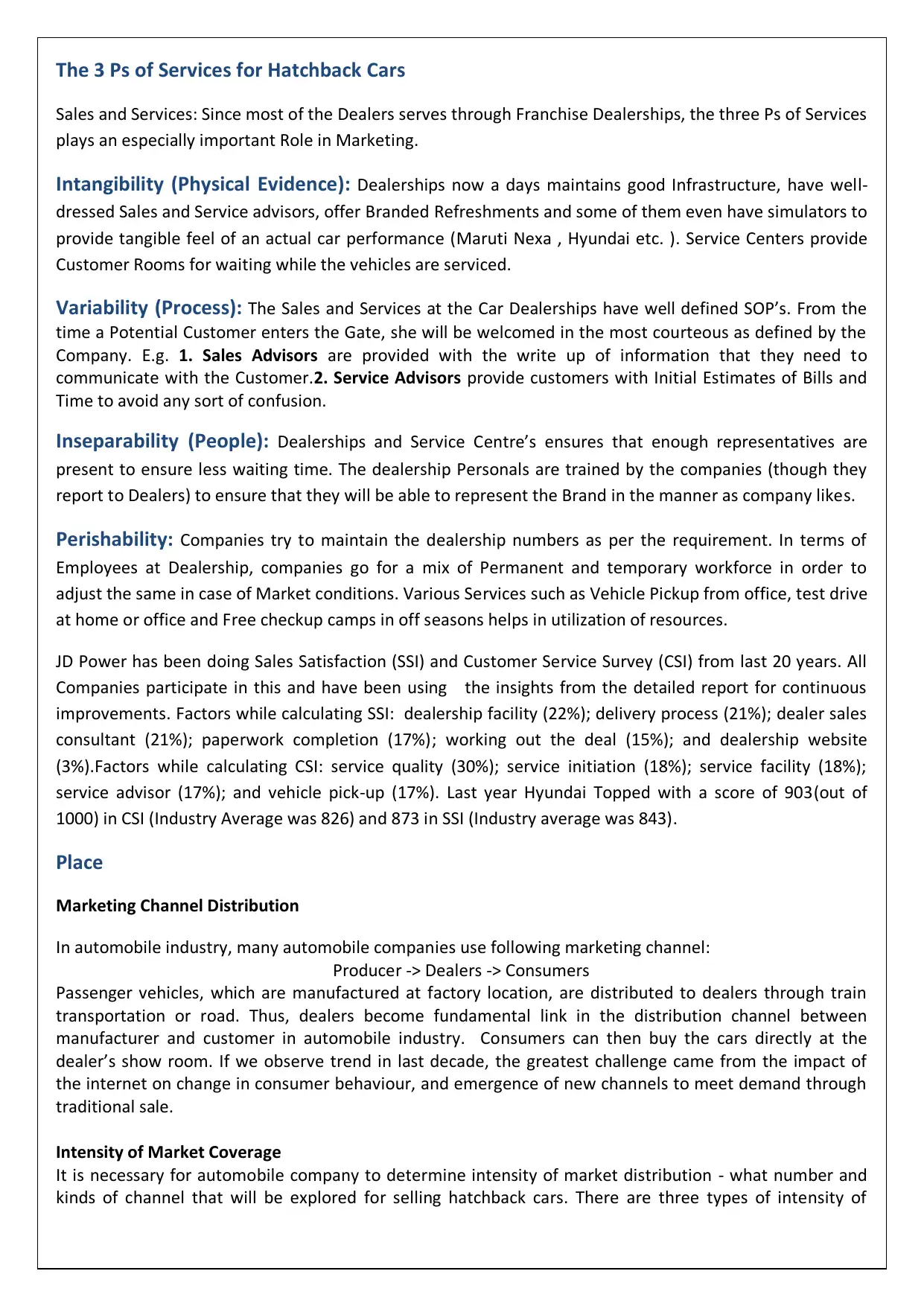
The 3 Ps of Services for Hatchback Cars
Sales and Services: Since most of the Dealers serves through Franchise Dealerships, the three Ps of Services
plays an especially important Role in Marketing.
Intangibility (Physical Evidence): Dealerships now a days maintains good Infrastructure, have well-
dressed Sales and Service advisors, offer Branded Refreshments and some of them even have simulators to
provide tangible feel of an actual car performance (Maruti Nexa , Hyundai etc. ). Service Centers provide
Customer Rooms for waiting while the vehicles are serviced.
Variability (Process): The Sales and Services at the Car Dealerships have well defined SOP’s. From the
time a Potential Customer enters the Gate, she will be welcomed in the most courteous as defined by the
Company. E.g. 1. Sales Advisors are provided with the write up of information that they need to
communicate with the Customer.2. Service Advisors provide customers with Initial Estimates of Bills and
Time to avoid any sort of confusion.
Inseparability (People): Dealerships and Service Centre’s ensures that enough representatives are
present to ensure less waiting time. The dealership Personals are trained by the companies (though they
report to Dealers) to ensure that they will be able to represent the Brand in the manner as company likes.
Perishability: Companies try to maintain the dealership numbers as per the requirement. In terms of
Employees at Dealership, companies go for a mix of Permanent and temporary workforce in order to
adjust the same in case of Market conditions. Various Services such as Vehicle Pickup from office, test drive
at home or office and Free checkup camps in off seasons helps in utilization of resources.
JD Power has been doing Sales Satisfaction (SSI) and Customer Service Survey (CSI) from last 20 years. All
Companies participate in this and have been using the insights from the detailed report for continuous
improvements. Factors while calculating SSI: dealership facility (22%); delivery process (21%); dealer sales
consultant (21%); paperwork completion (17%); working out the deal (15%); and dealership website
(3%).Factors while calculating CSI: service quality (30%); service initiation (18%); service facility (18%);
service advisor (17%); and vehicle pick-up (17%). Last year Hyundai Topped with a score of 903(out of
1000) in CSI (Industry Average was 826) and 873 in SSI (Industry average was 843).
Place
Marketing Channel Distribution
In automobile industry, many automobile companies use following marketing channel:
Producer -> Dealers -> Consumers
Passenger vehicles, which are manufactured at factory location, are distributed to dealers through train
transportation or road. Thus, dealers become fundamental link in the distribution channel between
manufacturer and customer in automobile industry. Consumers can then buy the cars directly at the
dealer’s show room. If we observe trend in last decade, the greatest challenge came from the impact of
the internet on change in consumer behaviour, and emergence of new channels to meet demand through
traditional sale.
Intensity of Market Coverage
It is necessary for automobile company to determine intensity of market distribution - what number and
kinds of channel that will be explored for selling hatchback cars. There are three types of intensity of
Sales and Services: Since most of the Dealers serves through Franchise Dealerships, the three Ps of Services
plays an especially important Role in Marketing.
Intangibility (Physical Evidence): Dealerships now a days maintains good Infrastructure, have well-
dressed Sales and Service advisors, offer Branded Refreshments and some of them even have simulators to
provide tangible feel of an actual car performance (Maruti Nexa , Hyundai etc. ). Service Centers provide
Customer Rooms for waiting while the vehicles are serviced.
Variability (Process): The Sales and Services at the Car Dealerships have well defined SOP’s. From the
time a Potential Customer enters the Gate, she will be welcomed in the most courteous as defined by the
Company. E.g. 1. Sales Advisors are provided with the write up of information that they need to
communicate with the Customer.2. Service Advisors provide customers with Initial Estimates of Bills and
Time to avoid any sort of confusion.
Inseparability (People): Dealerships and Service Centre’s ensures that enough representatives are
present to ensure less waiting time. The dealership Personals are trained by the companies (though they
report to Dealers) to ensure that they will be able to represent the Brand in the manner as company likes.
Perishability: Companies try to maintain the dealership numbers as per the requirement. In terms of
Employees at Dealership, companies go for a mix of Permanent and temporary workforce in order to
adjust the same in case of Market conditions. Various Services such as Vehicle Pickup from office, test drive
at home or office and Free checkup camps in off seasons helps in utilization of resources.
JD Power has been doing Sales Satisfaction (SSI) and Customer Service Survey (CSI) from last 20 years. All
Companies participate in this and have been using the insights from the detailed report for continuous
improvements. Factors while calculating SSI: dealership facility (22%); delivery process (21%); dealer sales
consultant (21%); paperwork completion (17%); working out the deal (15%); and dealership website
(3%).Factors while calculating CSI: service quality (30%); service initiation (18%); service facility (18%);
service advisor (17%); and vehicle pick-up (17%). Last year Hyundai Topped with a score of 903(out of
1000) in CSI (Industry Average was 826) and 873 in SSI (Industry average was 843).
Place
Marketing Channel Distribution
In automobile industry, many automobile companies use following marketing channel:
Producer -> Dealers -> Consumers
Passenger vehicles, which are manufactured at factory location, are distributed to dealers through train
transportation or road. Thus, dealers become fundamental link in the distribution channel between
manufacturer and customer in automobile industry. Consumers can then buy the cars directly at the
dealer’s show room. If we observe trend in last decade, the greatest challenge came from the impact of
the internet on change in consumer behaviour, and emergence of new channels to meet demand through
traditional sale.
Intensity of Market Coverage
It is necessary for automobile company to determine intensity of market distribution - what number and
kinds of channel that will be explored for selling hatchback cars. There are three types of intensity of
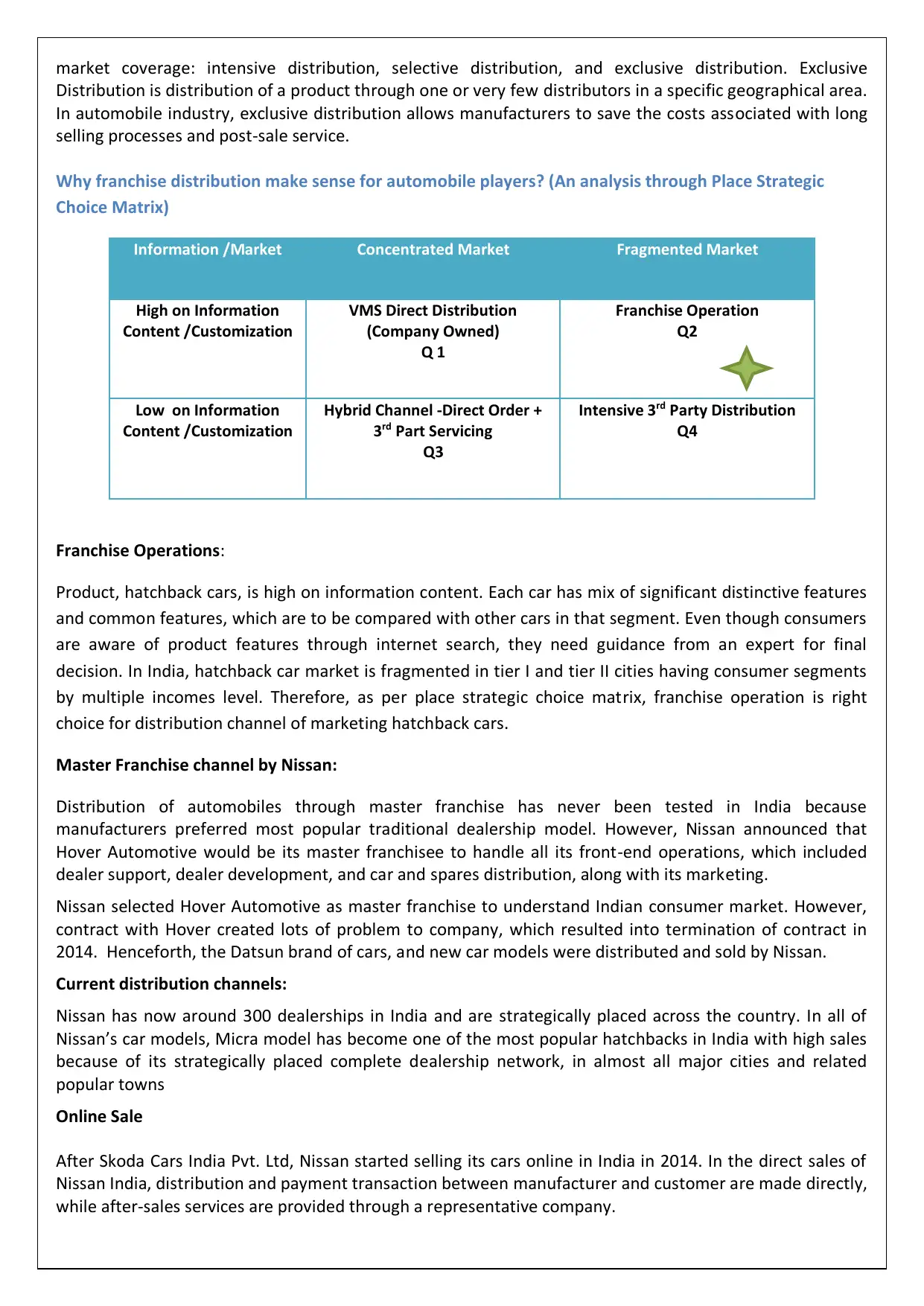
market coverage: intensive distribution, selective distribution, and exclusive distribution. Exclusive
Distribution is distribution of a product through one or very few distributors in a specific geographical area.
In automobile industry, exclusive distribution allows manufacturers to save the costs associated with long
selling processes and post-sale service.
Why franchise distribution make sense for automobile players? (An analysis through Place Strategic
Choice Matrix)
Information /Market Concentrated Market Fragmented Market
High on Information
Content /Customization
VMS Direct Distribution
(Company Owned)
Q 1
Franchise Operation
Q2
Low on Information
Content /Customization
Hybrid Channel -Direct Order +
3rd Part Servicing
Q3
Intensive 3rd Party Distribution
Q4
Franchise Operations:
Product, hatchback cars, is high on information content. Each car has mix of significant distinctive features
and common features, which are to be compared with other cars in that segment. Even though consumers
are aware of product features through internet search, they need guidance from an expert for final
decision. In India, hatchback car market is fragmented in tier I and tier II cities having consumer segments
by multiple incomes level. Therefore, as per place strategic choice matrix, franchise operation is right
choice for distribution channel of marketing hatchback cars.
Master Franchise channel by Nissan:
Distribution of automobiles through master franchise has never been tested in India because
manufacturers preferred most popular traditional dealership model. However, Nissan announced that
Hover Automotive would be its master franchisee to handle all its front-end operations, which included
dealer support, dealer development, and car and spares distribution, along with its marketing.
Nissan selected Hover Automotive as master franchise to understand Indian consumer market. However,
contract with Hover created lots of problem to company, which resulted into termination of contract in
2014. Henceforth, the Datsun brand of cars, and new car models were distributed and sold by Nissan.
Current distribution channels:
Nissan has now around 300 dealerships in India and are strategically placed across the country. In all of
Nissan’s car models, Micra model has become one of the most popular hatchbacks in India with high sales
because of its strategically placed complete dealership network, in almost all major cities and related
popular towns
Online Sale
After Skoda Cars India Pvt. Ltd, Nissan started selling its cars online in India in 2014. In the direct sales of
Nissan India, distribution and payment transaction between manufacturer and customer are made directly,
while after-sales services are provided through a representative company.
Distribution is distribution of a product through one or very few distributors in a specific geographical area.
In automobile industry, exclusive distribution allows manufacturers to save the costs associated with long
selling processes and post-sale service.
Why franchise distribution make sense for automobile players? (An analysis through Place Strategic
Choice Matrix)
Information /Market Concentrated Market Fragmented Market
High on Information
Content /Customization
VMS Direct Distribution
(Company Owned)
Q 1
Franchise Operation
Q2
Low on Information
Content /Customization
Hybrid Channel -Direct Order +
3rd Part Servicing
Q3
Intensive 3rd Party Distribution
Q4
Franchise Operations:
Product, hatchback cars, is high on information content. Each car has mix of significant distinctive features
and common features, which are to be compared with other cars in that segment. Even though consumers
are aware of product features through internet search, they need guidance from an expert for final
decision. In India, hatchback car market is fragmented in tier I and tier II cities having consumer segments
by multiple incomes level. Therefore, as per place strategic choice matrix, franchise operation is right
choice for distribution channel of marketing hatchback cars.
Master Franchise channel by Nissan:
Distribution of automobiles through master franchise has never been tested in India because
manufacturers preferred most popular traditional dealership model. However, Nissan announced that
Hover Automotive would be its master franchisee to handle all its front-end operations, which included
dealer support, dealer development, and car and spares distribution, along with its marketing.
Nissan selected Hover Automotive as master franchise to understand Indian consumer market. However,
contract with Hover created lots of problem to company, which resulted into termination of contract in
2014. Henceforth, the Datsun brand of cars, and new car models were distributed and sold by Nissan.
Current distribution channels:
Nissan has now around 300 dealerships in India and are strategically placed across the country. In all of
Nissan’s car models, Micra model has become one of the most popular hatchbacks in India with high sales
because of its strategically placed complete dealership network, in almost all major cities and related
popular towns
Online Sale
After Skoda Cars India Pvt. Ltd, Nissan started selling its cars online in India in 2014. In the direct sales of
Nissan India, distribution and payment transaction between manufacturer and customer are made directly,
while after-sales services are provided through a representative company.
⊘ This is a preview!⊘
Do you want full access?
Subscribe today to unlock all pages.

Trusted by 1+ million students worldwide
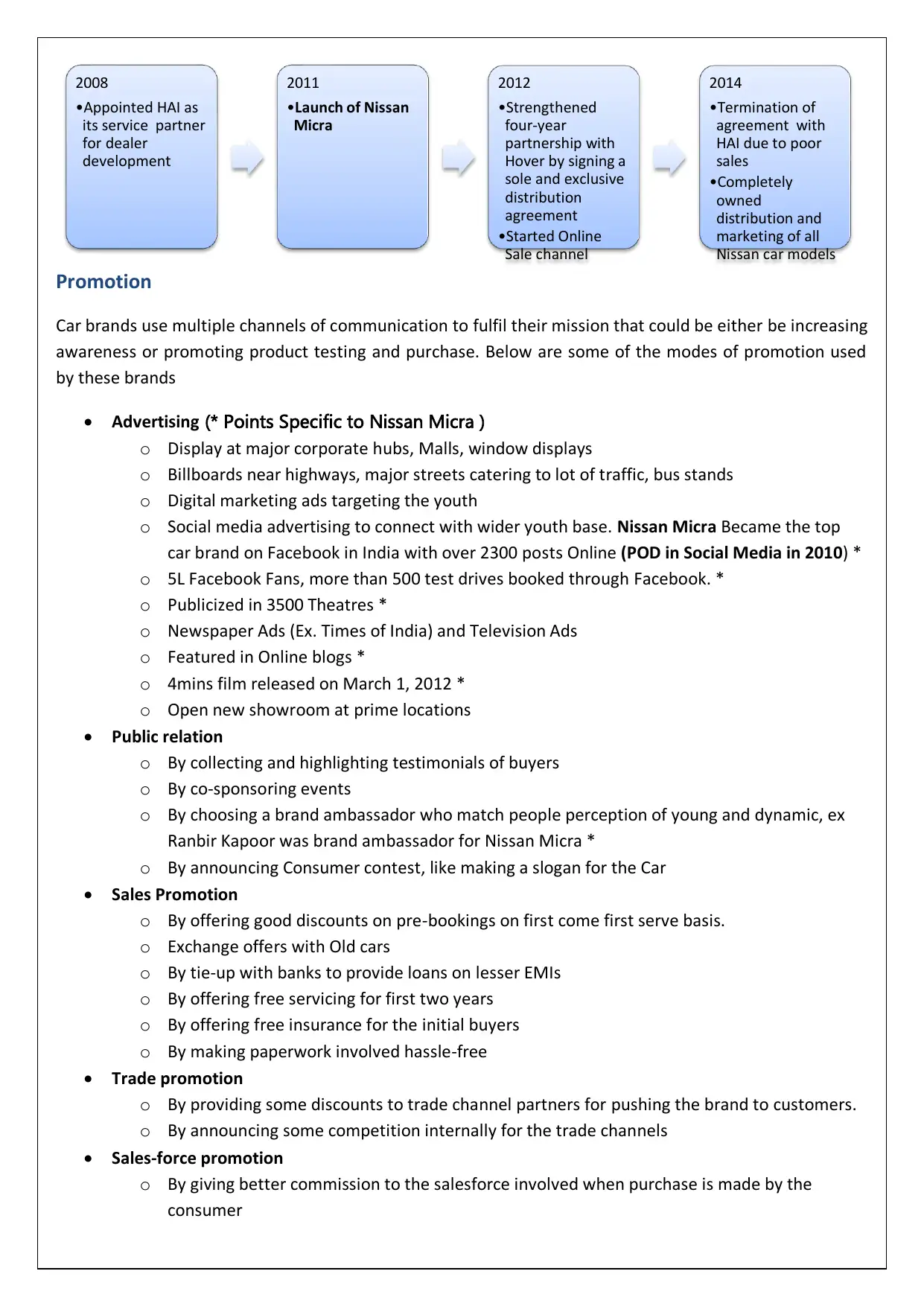
Promotion
Car brands use multiple channels of communication to fulfil their mission that could be either be increasing
awareness or promoting product testing and purchase. Below are some of the modes of promotion used
by these brands
• Advertising (* Points Specific to Nissan Micra )
o Display at major corporate hubs, Malls, window displays
o Billboards near highways, major streets catering to lot of traffic, bus stands
o Digital marketing ads targeting the youth
o Social media advertising to connect with wider youth base. Nissan Micra Became the top
car brand on Facebook in India with over 2300 posts Online (POD in Social Media in 2010) *
o 5L Facebook Fans, more than 500 test drives booked through Facebook. *
o Publicized in 3500 Theatres *
o Newspaper Ads (Ex. Times of India) and Television Ads
o Featured in Online blogs *
o 4mins film released on March 1, 2012 *
o Open new showroom at prime locations
• Public relation
o By collecting and highlighting testimonials of buyers
o By co-sponsoring events
o By choosing a brand ambassador who match people perception of young and dynamic, ex
Ranbir Kapoor was brand ambassador for Nissan Micra *
o By announcing Consumer contest, like making a slogan for the Car
• Sales Promotion
o By offering good discounts on pre-bookings on first come first serve basis.
o Exchange offers with Old cars
o By tie-up with banks to provide loans on lesser EMIs
o By offering free servicing for first two years
o By offering free insurance for the initial buyers
o By making paperwork involved hassle-free
• Trade promotion
o By providing some discounts to trade channel partners for pushing the brand to customers.
o By announcing some competition internally for the trade channels
• Sales-force promotion
o By giving better commission to the salesforce involved when purchase is made by the
consumer
2008
•Appointed HAI as
its service partner
for dealer
development
2011
•Launch of Nissan
Micra
2012
•Strengthened
four-year
partnership with
Hover by signing a
sole and exclusive
distribution
agreement
•Started Online
Sale channel
2014
•Termination of
agreement with
HAI due to poor
sales
•Completely
owned
distribution and
marketing of all
Nissan car models
Car brands use multiple channels of communication to fulfil their mission that could be either be increasing
awareness or promoting product testing and purchase. Below are some of the modes of promotion used
by these brands
• Advertising (* Points Specific to Nissan Micra )
o Display at major corporate hubs, Malls, window displays
o Billboards near highways, major streets catering to lot of traffic, bus stands
o Digital marketing ads targeting the youth
o Social media advertising to connect with wider youth base. Nissan Micra Became the top
car brand on Facebook in India with over 2300 posts Online (POD in Social Media in 2010) *
o 5L Facebook Fans, more than 500 test drives booked through Facebook. *
o Publicized in 3500 Theatres *
o Newspaper Ads (Ex. Times of India) and Television Ads
o Featured in Online blogs *
o 4mins film released on March 1, 2012 *
o Open new showroom at prime locations
• Public relation
o By collecting and highlighting testimonials of buyers
o By co-sponsoring events
o By choosing a brand ambassador who match people perception of young and dynamic, ex
Ranbir Kapoor was brand ambassador for Nissan Micra *
o By announcing Consumer contest, like making a slogan for the Car
• Sales Promotion
o By offering good discounts on pre-bookings on first come first serve basis.
o Exchange offers with Old cars
o By tie-up with banks to provide loans on lesser EMIs
o By offering free servicing for first two years
o By offering free insurance for the initial buyers
o By making paperwork involved hassle-free
• Trade promotion
o By providing some discounts to trade channel partners for pushing the brand to customers.
o By announcing some competition internally for the trade channels
• Sales-force promotion
o By giving better commission to the salesforce involved when purchase is made by the
consumer
2008
•Appointed HAI as
its service partner
for dealer
development
2011
•Launch of Nissan
Micra
2012
•Strengthened
four-year
partnership with
Hover by signing a
sole and exclusive
distribution
agreement
•Started Online
Sale channel
2014
•Termination of
agreement with
HAI due to poor
sales
•Completely
owned
distribution and
marketing of all
Nissan car models
Paraphrase This Document
Need a fresh take? Get an instant paraphrase of this document with our AI Paraphraser
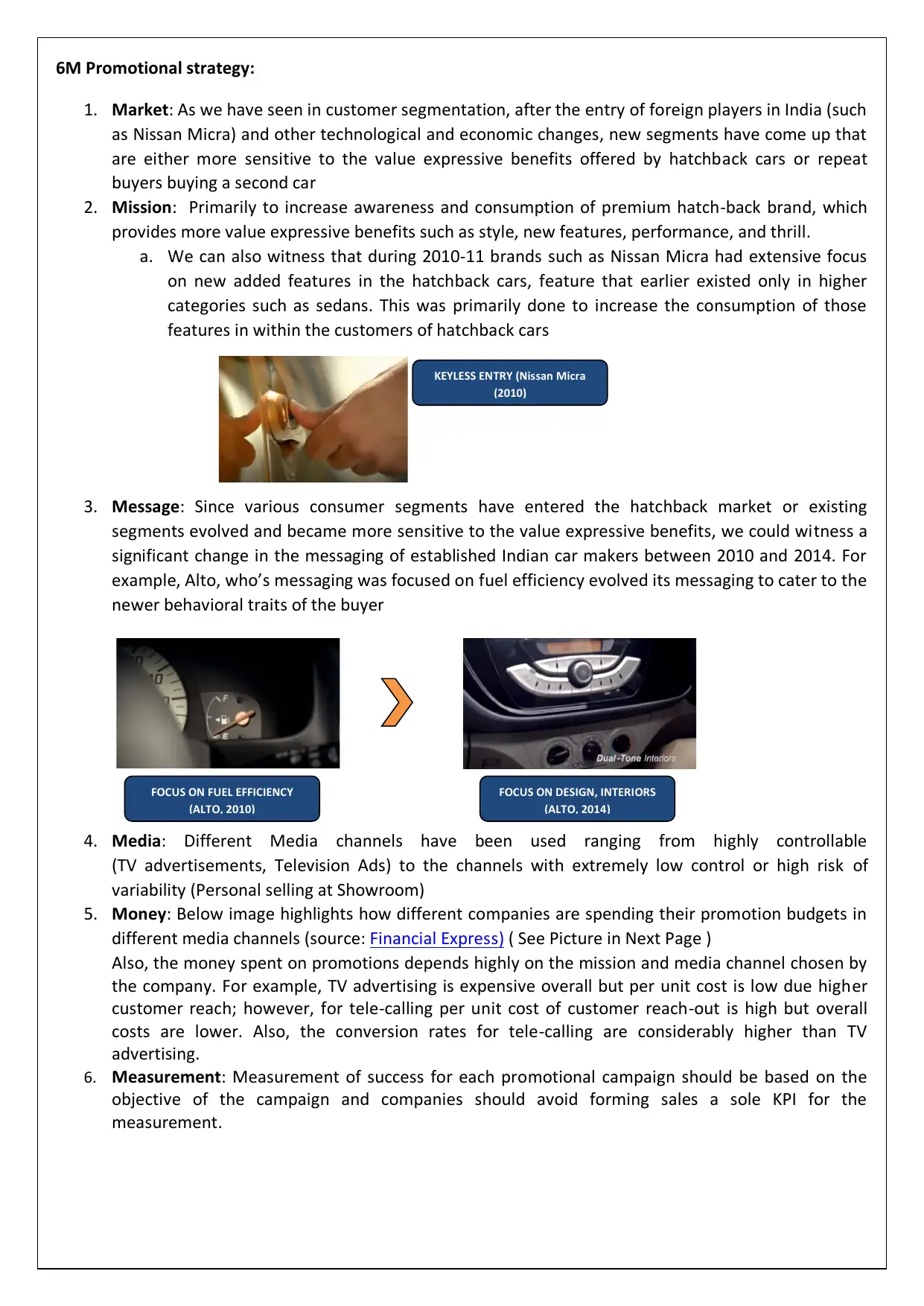
KEYLESS ENTRY (Nissan Micra
(2010)
FOCUS ON FUEL EFFICIENCY
(ALTO, 2010)
FOCUS ON DESIGN, INTERIORS
(ALTO, 2014)
6M Promotional strategy:
1. Market: As we have seen in customer segmentation, after the entry of foreign players in India (such
as Nissan Micra) and other technological and economic changes, new segments have come up that
are either more sensitive to the value expressive benefits offered by hatchback cars or repeat
buyers buying a second car
2. Mission: Primarily to increase awareness and consumption of premium hatch-back brand, which
provides more value expressive benefits such as style, new features, performance, and thrill.
a. We can also witness that during 2010-11 brands such as Nissan Micra had extensive focus
on new added features in the hatchback cars, feature that earlier existed only in higher
categories such as sedans. This was primarily done to increase the consumption of those
features in within the customers of hatchback cars
3. Message: Since various consumer segments have entered the hatchback market or existing
segments evolved and became more sensitive to the value expressive benefits, we could witness a
significant change in the messaging of established Indian car makers between 2010 and 2014. For
example, Alto, who’s messaging was focused on fuel efficiency evolved its messaging to cater to the
newer behavioral traits of the buyer
4. Media: Different Media channels have been used ranging from highly controllable
(TV advertisements, Television Ads) to the channels with extremely low control or high risk of
variability (Personal selling at Showroom)
5. Money: Below image highlights how different companies are spending their promotion budgets in
different media channels (source: Financial Express) ( See Picture in Next Page )
Also, the money spent on promotions depends highly on the mission and media channel chosen by
the company. For example, TV advertising is expensive overall but per unit cost is low due higher
customer reach; however, for tele-calling per unit cost of customer reach-out is high but overall
costs are lower. Also, the conversion rates for tele-calling are considerably higher than TV
advertising.
6. Measurement: Measurement of success for each promotional campaign should be based on the
objective of the campaign and companies should avoid forming sales a sole KPI for the
measurement.
(2010)
FOCUS ON FUEL EFFICIENCY
(ALTO, 2010)
FOCUS ON DESIGN, INTERIORS
(ALTO, 2014)
6M Promotional strategy:
1. Market: As we have seen in customer segmentation, after the entry of foreign players in India (such
as Nissan Micra) and other technological and economic changes, new segments have come up that
are either more sensitive to the value expressive benefits offered by hatchback cars or repeat
buyers buying a second car
2. Mission: Primarily to increase awareness and consumption of premium hatch-back brand, which
provides more value expressive benefits such as style, new features, performance, and thrill.
a. We can also witness that during 2010-11 brands such as Nissan Micra had extensive focus
on new added features in the hatchback cars, feature that earlier existed only in higher
categories such as sedans. This was primarily done to increase the consumption of those
features in within the customers of hatchback cars
3. Message: Since various consumer segments have entered the hatchback market or existing
segments evolved and became more sensitive to the value expressive benefits, we could witness a
significant change in the messaging of established Indian car makers between 2010 and 2014. For
example, Alto, who’s messaging was focused on fuel efficiency evolved its messaging to cater to the
newer behavioral traits of the buyer
4. Media: Different Media channels have been used ranging from highly controllable
(TV advertisements, Television Ads) to the channels with extremely low control or high risk of
variability (Personal selling at Showroom)
5. Money: Below image highlights how different companies are spending their promotion budgets in
different media channels (source: Financial Express) ( See Picture in Next Page )
Also, the money spent on promotions depends highly on the mission and media channel chosen by
the company. For example, TV advertising is expensive overall but per unit cost is low due higher
customer reach; however, for tele-calling per unit cost of customer reach-out is high but overall
costs are lower. Also, the conversion rates for tele-calling are considerably higher than TV
advertising.
6. Measurement: Measurement of success for each promotional campaign should be based on the
objective of the campaign and companies should avoid forming sales a sole KPI for the
measurement.
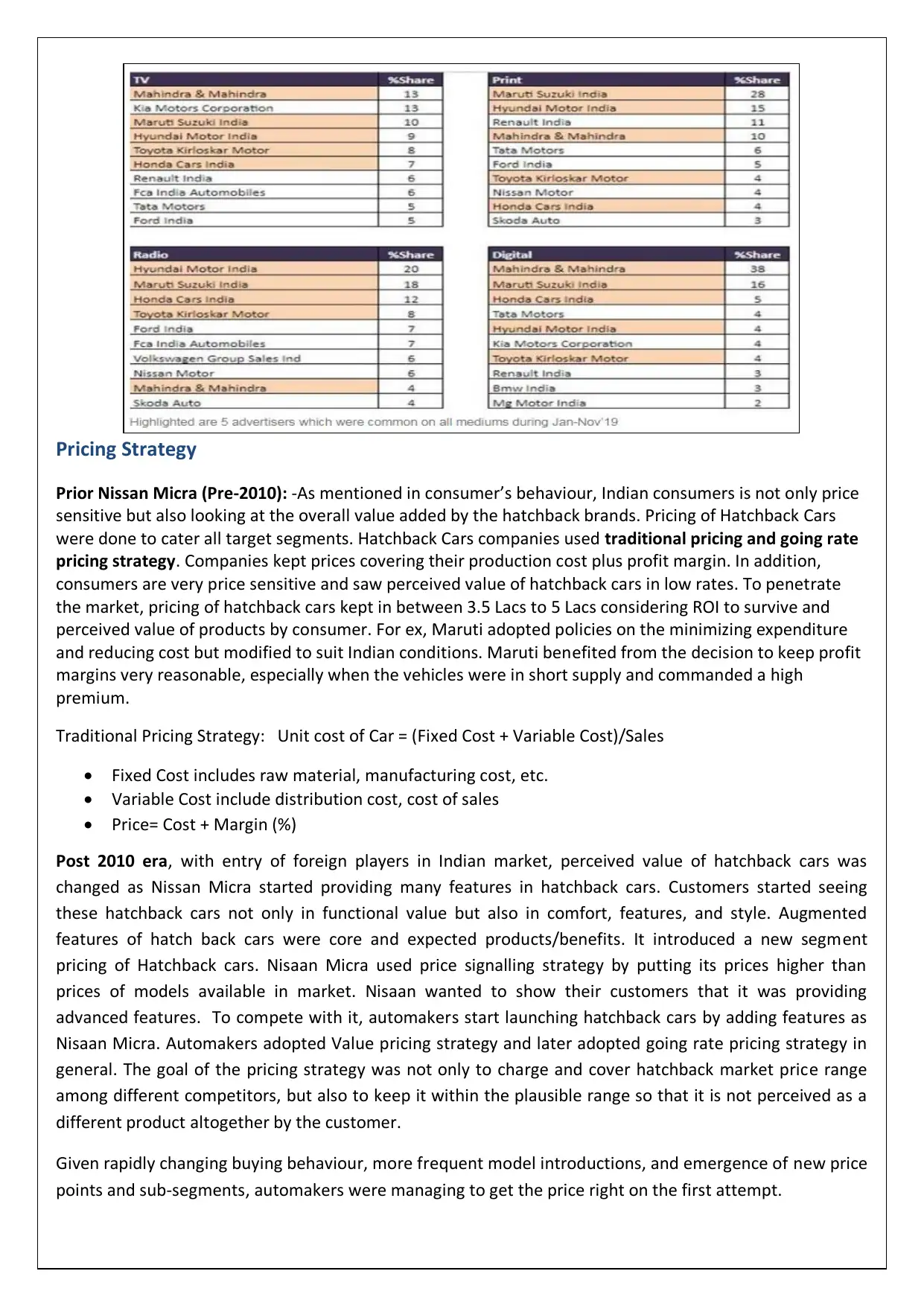
Pricing Strategy
Prior Nissan Micra (Pre-2010): -As mentioned in consumer’s behaviour, Indian consumers is not only price
sensitive but also looking at the overall value added by the hatchback brands. Pricing of Hatchback Cars
were done to cater all target segments. Hatchback Cars companies used traditional pricing and going rate
pricing strategy. Companies kept prices covering their production cost plus profit margin. In addition,
consumers are very price sensitive and saw perceived value of hatchback cars in low rates. To penetrate
the market, pricing of hatchback cars kept in between 3.5 Lacs to 5 Lacs considering ROI to survive and
perceived value of products by consumer. For ex, Maruti adopted policies on the minimizing expenditure
and reducing cost but modified to suit Indian conditions. Maruti benefited from the decision to keep profit
margins very reasonable, especially when the vehicles were in short supply and commanded a high
premium.
Traditional Pricing Strategy: Unit cost of Car = (Fixed Cost + Variable Cost)/Sales
• Fixed Cost includes raw material, manufacturing cost, etc.
• Variable Cost include distribution cost, cost of sales
• Price= Cost + Margin (%)
Post 2010 era, with entry of foreign players in Indian market, perceived value of hatchback cars was
changed as Nissan Micra started providing many features in hatchback cars. Customers started seeing
these hatchback cars not only in functional value but also in comfort, features, and style. Augmented
features of hatch back cars were core and expected products/benefits. It introduced a new segment
pricing of Hatchback cars. Nisaan Micra used price signalling strategy by putting its prices higher than
prices of models available in market. Nisaan wanted to show their customers that it was providing
advanced features. To compete with it, automakers start launching hatchback cars by adding features as
Nisaan Micra. Automakers adopted Value pricing strategy and later adopted going rate pricing strategy in
general. The goal of the pricing strategy was not only to charge and cover hatchback market price range
among different competitors, but also to keep it within the plausible range so that it is not perceived as a
different product altogether by the customer.
Given rapidly changing buying behaviour, more frequent model introductions, and emergence of new price
points and sub-segments, automakers were managing to get the price right on the first attempt.
Prior Nissan Micra (Pre-2010): -As mentioned in consumer’s behaviour, Indian consumers is not only price
sensitive but also looking at the overall value added by the hatchback brands. Pricing of Hatchback Cars
were done to cater all target segments. Hatchback Cars companies used traditional pricing and going rate
pricing strategy. Companies kept prices covering their production cost plus profit margin. In addition,
consumers are very price sensitive and saw perceived value of hatchback cars in low rates. To penetrate
the market, pricing of hatchback cars kept in between 3.5 Lacs to 5 Lacs considering ROI to survive and
perceived value of products by consumer. For ex, Maruti adopted policies on the minimizing expenditure
and reducing cost but modified to suit Indian conditions. Maruti benefited from the decision to keep profit
margins very reasonable, especially when the vehicles were in short supply and commanded a high
premium.
Traditional Pricing Strategy: Unit cost of Car = (Fixed Cost + Variable Cost)/Sales
• Fixed Cost includes raw material, manufacturing cost, etc.
• Variable Cost include distribution cost, cost of sales
• Price= Cost + Margin (%)
Post 2010 era, with entry of foreign players in Indian market, perceived value of hatchback cars was
changed as Nissan Micra started providing many features in hatchback cars. Customers started seeing
these hatchback cars not only in functional value but also in comfort, features, and style. Augmented
features of hatch back cars were core and expected products/benefits. It introduced a new segment
pricing of Hatchback cars. Nisaan Micra used price signalling strategy by putting its prices higher than
prices of models available in market. Nisaan wanted to show their customers that it was providing
advanced features. To compete with it, automakers start launching hatchback cars by adding features as
Nisaan Micra. Automakers adopted Value pricing strategy and later adopted going rate pricing strategy in
general. The goal of the pricing strategy was not only to charge and cover hatchback market price range
among different competitors, but also to keep it within the plausible range so that it is not perceived as a
different product altogether by the customer.
Given rapidly changing buying behaviour, more frequent model introductions, and emergence of new price
points and sub-segments, automakers were managing to get the price right on the first attempt.
⊘ This is a preview!⊘
Do you want full access?
Subscribe today to unlock all pages.

Trusted by 1+ million students worldwide
1 out of 12
Your All-in-One AI-Powered Toolkit for Academic Success.
+13062052269
info@desklib.com
Available 24*7 on WhatsApp / Email
![[object Object]](/_next/static/media/star-bottom.7253800d.svg)
Unlock your academic potential
Copyright © 2020–2025 A2Z Services. All Rights Reserved. Developed and managed by ZUCOL.

